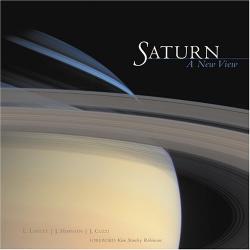
I love large format picture books. Most any subject suffices, as the photographs are like little works of art, each selected with care and passion. However, space themed books are real treasures for me, and Saturn – A New View by L.Lovett, J.Horvath, and, J.Cuzzi is a jewel in the treasure chest. Within it, wide expansive images bring this distant planet into immediate, astounding view.
The Cassini-Huygens probe is the source for the Saturn images in this book. These are ‘hot off the press’ so to speak, even while new images arrive daily. Through the effort of the authors and others, the vast quantity of existing scientific imagery was culled into this poignant collection. Rings, moons, craters and horizons pointedly raise to the fore the beauty, intricacy and wonder of Saturn as a little planetary system of its own.
As mentioned, the images are direct from the source; NASA. Further, many, if not most, are in natural colour. This heightens the impression of nearness to the subject, as the reader can readily imagine his or her presence near the ringed world. In further acknowledgement to the author’s efforts, some of the book’s images are comprehensive mosaics. For example, one is a compilation of 42 overlapping shots that result in a perspective that spans across two pages of the book. Though anyone can access the source files using the Web, they’d need years to find and collate these special images and they’d have to prepare their own supporting text. Hence, this book saves a lot of time.
As mentioned, there is some text in this book. Nearly all images have a brief paragraph stating the subject matter. As well, a few short passages, like essays, are inter-spaced amongst the images. These notes serve to add the authors’ learned background on particular aspects of the subject matter. There’s the history of telescopes and inter-planetary probes, the ring system of Saturn and the moons of Saturn. The ideas either directly enhance certain images, like the changing colour of Saturn, or describe a relevant aspect, such as the Cassini-Huygens probe and its special journey. These worthwhile accrutments add technical information at the generalist level and heighten the value of the images by adding background, detail and noteworthy elements. The target audience is the general reader, so no background knowledge is necessary.
In a quantitative assessment, the book has about 200 pages. Many wonderful images span across two pages, while others fill the full extent of single pages. These are the majority. Collages of smaller images arise, usually for comparative purposes. And though one might think that Saturn and its rings might get a bit repetitive, there’s more than enough variety. Whether from perspective or colour, the reader will keep on turning the pages and return after the book is completed. Whether a gift, a personal treat or as an enticement to explore space further, this book well satisfies.
Philosophers wonder if falling trees make sound when no one is around. Similarly, we wondered if other planets of our solar system were beautiful even though we had never seen them. The book Saturn – A New View by L.Lovett, J.Horvath, and, J.Cuzzi does show that beauty exists in places other than Earth. Let’s hope we continue to obtain and share such great images from world’s we can only now imagine.
